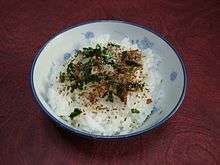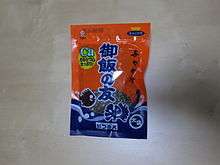Furikake

Furikake (振り掛け / ふりかけ) is a dry Japanese seasoning[1] meant to be sprinkled on top of cooked rice, vegetables, and fish. It typically consists of a mixture of dried and ground fish, sesame seeds, chopped seaweed, sugar, salt, and monosodium glutamate.[2][3] Other flavorful ingredients such as katsuobushi (sometimes indicated on the package as bonito), or okaka (bonito flakes moistened with soy sauce and dried again), freeze-dried salmon particles, shiso, egg, powdered miso, vegetables, etc., are often added to the mix.[3]
Furikake is often brightly colored and flaky. It can have a slight fish or seafood flavoring, and is sometimes spicy. It can be used in Japanese cooking for pickling foods and for rice balls (onigiri). Since 2003, furikake has increasingly gained acceptance in the US (particularly in Hawaii and the West Coast) as a seasoning for baked or fried fish,[4] raw fish salads [5] and snack foods such as furikake party mix.[6]
Outside Japan, furikake can be found in most Asian groceries (near the katsuobushi) or in the ethnic food aisle of some major supermarkets.
History

One account of the origin of furikake is that it was developed during the Taisho period (1912–1926) by a pharmacist residing in Kumamoto prefecture named Suekichi Yoshimaru (吉丸末吉).[7][8] To address calcium deficits in the Japanese population at the time, Yoshimaru developed a mixture of ground fish bones with roast sesame seeds, poppy seeds, and seaweed that was made into a powder. He called this product Gohan No Tomo (ご飯の友 "A Friend For Rice") and is generally considered the precursor to contemporary furikake. A food company in Kumamato later acquired the product and was able to sell it commercially.[7] It was initially sold in a flask-like container shaped with a narrow neck to prevent moisture from seeping into the product.[8]
Years after Yoshimari's Gohan No Tomo, a grocery retailer in Fukushima City named Seiichirō Kai developed a different mixture consisting of white croaker and powdered kombu and other ingredients simmered with a soy sauce-based broth. Kai called this product Kore Wa Umai (これは旨い "This Is Good"), and was popular on its release. Although Kore Wa Umai was initially considered a luxury item only available to the affluent who were able to consume white rice on a regular basis, it later was made accessible to the Japanese working class.[8]
Availability of furikake in Japan increased starting shortly after September 1948 when Nissin Foods began to manufacture it on a large scale to address pervasive malnourishment. The product was commercialized on the basis that it provided a good source of both protein and calcium.[9] Furikake was also made widely available as it was dispensed to those serving in the Japanese military starting in World War I.[8]
The term furikake was used generically to describe the product starting in 1959 with the formation of the National Furikake Association. Since 1959, different furikake products are usually differentiated by their particular ingredients, such as in salmon furikake and sesame-and-salt furikake.[8]
See also
| Wikimedia Commons has media related to Furikake. |
- Gomashio—a type of furikake mostly consisting of cooked black sesame seeds and sea salt crystals.
- Shichimi—a chili-based spice mixture similar to furikake, but mainly used on noodles, soups and gyūdon.
- Ochazuke—a soup made by sprinkling any desired seasonings (such as furikake) and toppings over cooked rice, then covering with brewed green tea.
- Chutney—Indian condiments. Dry powdered chutney is eaten in a similar way.
References
- ↑ Japanese Furikake (Rice Seasoning). Japanese Kitchen. Accessed 28 October 2009.
- ↑ Mouritsen, Ole G. (2009). Sushi food for the eye, the body & the soul (2nd ed.). New York: Springer. p. 113. ISBN 1441906185.
- 1 2 Ambrose, Amber (12 April 2010). "Random Ingredient of the Week: Furikake". Houston Press. Retrieved 22 November 2015.
- ↑ Baked furikake salmon. Fujita & Miura Public Relations. Accessed 24 March 2012.
- ↑ Furikake salmon poki. Food Network.com. Accessed 24 March 2012.
- ↑ Furikake party mix recipe. Feeding My Ohana. Accessed 24 March 2012.
- 1 2 Ishizaki, Nobuo. "Innovative flavors put furikake back in spotlight". The Japan News. Yomiuri Shimbun. Retrieved 22 November 2015.
- 1 2 3 4 5 "Introducing furikake: making rice even tastier!". The Japan Australia News. Kyodo News. March 2013. p. 13. Retrieved 22 November 2015.
- ↑ Solt, George (2014). The Untold History of Ramen: How Political Crisis in Japan Spawned a Global Food Craze. Berkeley: University of California Press. p. 96. ISBN 0520958373.